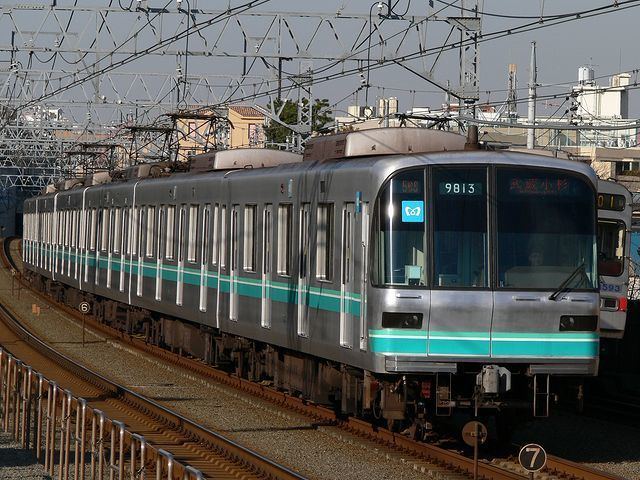In service 1991–Present Refurbishment 2016– Number in service 138 cars (23 sets) | Constructed 1990–2009 Number built 138 cars (23 sets) | |
 | ||
Manufacturer Kawasaki Heavy Industries, Nippon Sharyo, Tokyu Car Corporation | ||
The Tokyo Metro 9000 series (東京地下鉄9000系, Tōkyō Chikatetsu 9000-kei) is an electric multiple unit (EMU) train type operated by the Tokyo subway operator Tokyo Metro on the Tokyo Metro Namboku Line in Tokyo, Japan, since 1991.
Contents
Variants
As of 1 April 2015, the fleet consists of 23 six-car sets (numbered 01 to 23), all based at Oji depot in Tokyo.
Prototype
A prototype four-car set was built by Kawasaki Heavy Industries in 1990 (formed of cars 9101-9201-9301-9801) for testing on the Chiyoda Line prior to the opening of the Namboku Line in 1991.
1st batch
Full-production four-car sets 02 to 07 were delivered in 1991 ahead of the Namboku Line opening, followed by an additional set in 1992, set 08, to act as a spare.
The original four-car sets were reformed as six-car sets coinciding with the opening of the extension of the line from Yotsuya to Komagome on 26 March 1996. This was achieved by renumbering the centre cars (9200 and 9300) of sets 02, 04, 06, and 08 as 9600 and 9700 cars which were inserted into sets 01, 03, 05, and 07. New-build (2nd batch) intermediate cars (9200-9300-9600-9700) were then inserted into sets 02, 04, 06, and 08. The resulting minor differences led to odd-numbered sets 01 to 07 being classified as "A sets", and even-numbered sets 02 to 08 becoming "B sets".
2nd batch
Four new six-car sets (09 to 13) plus the four sets of four additional intermediate cars described above were built by Kawasaki Heavy Industries between 1995 and 1996, coinciding with the opening of the extension of the line from Yotsuya to Komagome in March 1996. Floor height was reduced by 5 mm compared with the 1st-batch sets from 1,155 mm to 1,150 mm. Seat width was increased from 440 mm to 450 mm.
3rd batch
Two new six-car sets (14 and 15) were built by Tokyu Car Corporation to coincide with the opening of the extension of the line from Yotsuya to Tameike-Sannō on 20 September 1997. Externally and internally, these were identical to the 2nd-batch trains.
4th batch
Six new six-car sets (16 to 21) were built by Nippon Sharyo between 1999 and 2000 ahead of the opening of the extension of the line from Tameike-Sannō to Meguro on 26 September 2000. The motored cars 3 (9300) and 4 (9600) in these sets have only one powered bogie, as opposed to two on earlier sets. Friction stir welding was used in the construction of these sets to produce a more attractive exterior finish.
5th batch
Two new six-car sets (22 and 23) entered service from 22 May 2009. These include a number of design improvements over earlier sets, including a redesigned front end, single-arm pantographs, and improved air-conditioning. The number of motored cars is reduced from four to three per 6-car set, with car 3 (trailer car) numbered in the 9400 series. Car 4 (9600) has both bogies powered. Seat width is increased 10 mm to 460 mm, and floor height is reduced 10 mm to 1,140 mm.
Sets 01 to 21
The 1st to 4th batch sets (01-21) are formed identically as follows, with four motored ("M") cars and two non-powered trailer ("T") cars, and car 1 at the northern end. Motored cars 3 and 4 in sets 16 to 21 each have only one motored bogie.
Sets 22-23
The two fifth-batch sets are formed as follows, with three motored ("M") cars and three non-powered trailer ("T") cars, and car 1 at the northern end.
Refurbishment
The early sets (01 to 08) are scheduled to undergo a programme of refurbishment from 2016, with the first treated sets returning to service from August 2016. Internally, the transverse seating bays at the ends of cars will be replaced buy longitudinal bench seats, and wheelchair spaces will be added to one end of each car. Externally, the refurbished sets will receive a revised livery with wavy turquoise and white stripes at waist height and shoulder height to make the line colour more visible at stations with platform edge doors.
